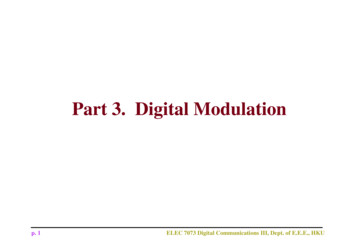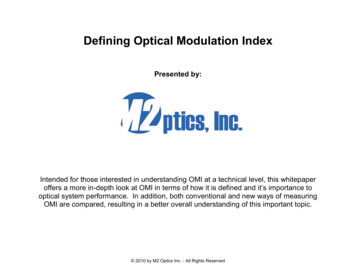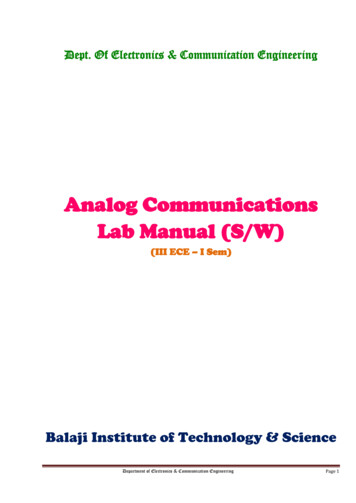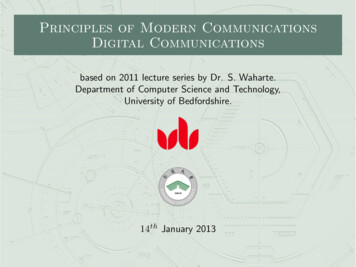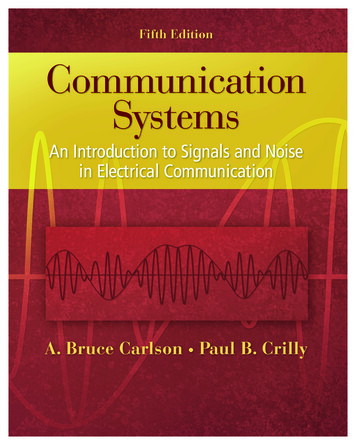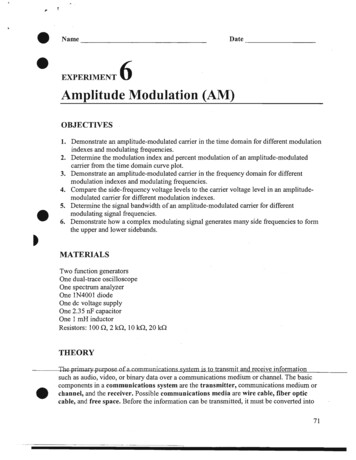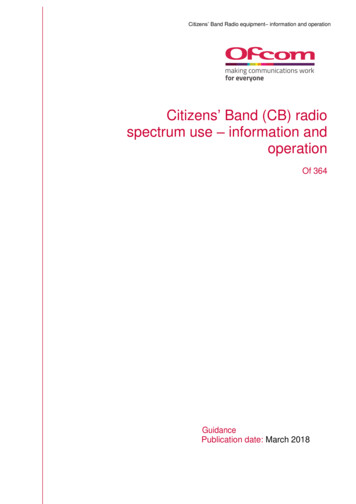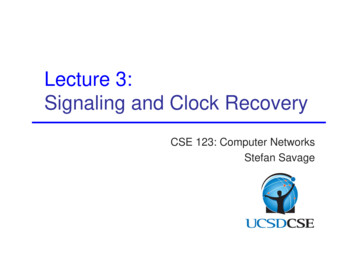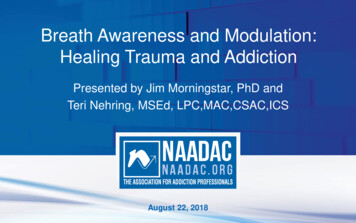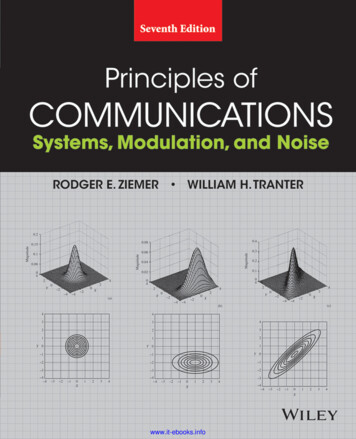
Transcription
www.it-ebooks.info
www.it-ebooks.info
PRINCIPLES OFCOMMUNICATIONSSystems, Modulation,and NoiseSEVENTH EDITIONRODGER E. ZIEMERUniversity of Colorado at Colorado SpringsWILLIAM H. TRANTERVirginia Polytechnic Institute and State Universitywww.it-ebooks.info
VP & PUBLISHER:EXECUTIVE EDITOR:SPONSORING EDITOR:PROJECT EDITOR:COVER DESIGNER:ASSOCIATE PRODUCTION MANAGER:SENIOR PRODUCTION EDITOR:PRODUCTION MANAGEMENT SERVICES:COVER ILLUSTRATION CREDITS:Don FowleyDan SayreMary O’SullivanEllen KeohaneKenji NgiengJoyce PohJolene LingThomson Digital Rodger E. Ziemer, William H. TranterThis book was set by Thomson Digital.Founded in 1807, John Wiley & Sons, Inc. has been a valued source of knowledge and understanding for more than200 years, helping people around the world meet their needs and fulfill their aspirations. Our company is built on afoundation of principles that include responsibility to the communities we serve and where we live and work. In2008, we launched a Corporate Citizenship Initiative, a global effort to address the environmental, social, economic,and ethical challenges we face in our business. Among the issues we are addressing are carbon impact, paperspecifications and procurement, ethical conduct within our business and among our vendors, and community andcharitable support. For more information, please visit our website: www.wiley.com/go/citizenship.Copyright 2015, 2009, 2002, 1995 John Wiley & Sons, Inc. All rights reserved. No part of this publication may bereproduced, stored in a retrieval system or transmitted in any form or by any means, electronic, mechanical,photocopying, recording, scanning or otherwise, except as permitted under Sections 107 or 108 of the 1976 UnitedStates Copyright Act, without either the prior written permission of the Publisher, or authorization through paymentof the appropriate per-copy fee to the Copyright Clearance Center, Inc. 222 Rosewood Drive, Danvers, MA 01923,website www.copyright.com. Requests to the Publisher for permission should be addressed to the PermissionsDepartment, John Wiley & Sons, Inc., 111 River Street, Hoboken, NJ 07030-5774, (201)748-6011,fax (201)748-6008, website http://www.wiley.com/go/permissions.Evaluation copies are provided to qualified academics and professionals for review purposes only, for use in theircourses during the next academic year. These copies are licensed and may not be sold or transferred to a third party.Upon completion of the review period, please return the evaluation copy to Wiley. Return instructions and a free ofcharge return mailing label are available at www.wiley.com/go/returnlabel. If you have chosen to adopt thistextbook for use in your course, please accept this book as your complimentary desk copy. Outside of the UnitedStates, please contact your local sales representative.Library of Congress Cataloging-in-Publication Data:Ziemer, Rodger E.Principles of communication : systems, modulation, and noise / Rodger E. Ziemer,William H. Tranter. Seventh edition.pages cmIncludes bibliographical references and index.ISBN 978-1-118-07891-4 (paper)1. Telecommunication. 2. Signal theory (Telecommunication) I. Tranter,William H. II. Title.TK5105.Z54 2014621.382’2 dc232013034294Printed in the United States of America10987654321www.it-ebooks.info
PREFACEThe first edition of this book was published in 1976, less than a decade after Neil Armstrong became thefirst man to walk on the moon in 1969. The programs that lead to the first moon landing gave birth tomany advances in science and technology. A number of these advances, especially those in microelectronicsand digital signal processing (DSP), became enabling technologies for advances in communications. Forexample, prior to 1969, essentially all commercial communication systems, including radio, telephones, andtelevision, were analog. Enabling technologies gave rise to the internet and the World Wide Web, digital radioand television, satellite communications, Global Positioning Systems, cellular communications for voice anddata, and a host of other applications that impact our daily lives. A number of books have been written thatprovide an in-depth study of these applications. In this book we have chosen not to cover application areas indetail but, rather, to focus on basic theory and fundamental techniques. A firm understanding of basic theoryprepares the student to pursue study of higher-level theoretical concepts and applications.True to this philosophy, we continue to resist the temptation to include a variety of new applicationsand technologies in this edition and believe that application examples and specific technologies, which oftenhave short lifetimes, are best treated in subsequent courses after students have mastered the basic theory andanalysis techniques. Reactions to previous editions have shown that emphasizing fundamentals, as opposedto specific technologies, serve the user well while keeping the length of the book reasonable. This strategyappears to have worked well for advanced undergraduates, for new graduate students who may have forgottensome of the fundamentals, and for the working engineer who may use the book as a reference or who maybe taking a course after-hours. New developments that appear to be fundamental, such as multiple-inputmultiple-output (MIMO) systems and capacity-approaching codes, are covered in appropriate detail.The two most obvious changes to the seventh edition of this book are the addition of drill problems tothe Problems section at the end of each chapter and the division of chapter three into two chapters. The drillproblems provide the student problem-solving practice with relatively simple problems. While the solutionsto these problems are straightforward, the complete set of drill problems covers the important concepts ofeach chapter. Chapter 3, as it appeared in previous editions, is now divided into two chapters mainly due tolength. Chapter 3 now focuses on linear analog modulation and simple discrete-time modulation techniquesthat are direct applications of the sampling theorem. Chapter 4 now focuses on nonlinear modulationtechniques. A number of new or revised end-of-chapter problems are included in all chapters.In addition to these obvious changes, a number of other changes have been made in edition seven. Anexample on signal space was deleted from Chapter 2 since it is really not necessary at this point in the book.(Chapter 11 deals more fully with the concepts of signal space.) Chapter 3, as described in the previousparagraph, now deals with linear analog modulation techniques. A section on measuring the modulation indexof AM signals and measuring transmitter linearity has been added. The section on analog television has beendeleted from Chapter 3 since it is no longer relevant. Finally, the section on adaptive delta modulation hasbeen deleted. Chapter 4 now deals with non-linear analog modulation techniques. Except for the problems,no significant additions or deletions have been made to Chapter 5. The same is true of Chapters 6 and 7,which treat probability and random processes, respectively. A section on signal-to-noise ratio measurementhas been added to Chapter 8, which treats noise effects in modulation systems. More detail on basic channeliiiwww.it-ebooks.info
ivPrefacemodels for fading channels has been added in Chapter 9 along with simulation results for bit error rate (BER)performance of a minimum mean-square error (MMSE) equalizer with optimum weights and an additionalexample of the MMSE equalizer with adaptive weights. Several changes have been made to Chapter 10.Satellite communications was reluctantly deleted because it would have required adding several additionalpages to do it justice. A section was added on MIMO systems using the Alamouti approach, which concludeswith a BER curve comparing performances of 2-transmit 1-receive Alamouti signaling in a Rayleigh fadingchannel with a 2-transmit 2-receive diversity system. A short discussion was also added to Chapter 10illustrating the features of 4G cellular communications as compared with 2G and 3G systems. With theexception of the Problems, no changes have been made to Chapter 11. A ‘‘Quick Overview’’ section hasbeen added to Chapter 12 discussing capacity-approaching codes, run-length codes, and digital television.A feature of the later editions of Principles of Communications was the inclusion of several computerexamples within each chapter. (MATLAB was chosen for these examples because of its widespread usein both academic and industrial settings, as well as for MATLAB’s rich graphics library.) These computerexamples, which range from programs for computing performance curves to simulation programs for certaintypes of communication systems and algorithms, allow the student to observe the behavior of more complexsystems without the need for extensive computations. These examples also expose the student to moderncomputational tools for analysis and simulation in the context of communication systems. Even though wehave limited the amount of this material in order to ensure that the character of the book is not changed,the number of computer examples has been increased for the seventh edition. In addition to the in-chaptercomputer examples, a number of ‘‘computer exercises’’ are included at the end of each chapter. The numberof these has also been increased in the seventh edition. These exercises follow the end-of-chapter problemsand are designed to make use of the computer in order to illustrate basic principles and to provide the studentwith additional insight. A number of new problems have been included at the end of each chapter in additionto a number of problems that were revised from the previous edition.The publisher maintains a web site from which the source code for all in-chapter computer examplescan be downloaded. Also included on the web site are Appendix G (answers to the drill problems) and thebibliography. The URL iswww.wiley.com/college/ziemerWe recommend that, although MATLAB code is included in the text, students download MATLAB codeof interest from the publisher website. The code in the text is subject to printing and other types of errors andis included to give the student insight into the computational techniques used for the illustrative examples.In addition, the MATLAB code on the publisher website is periodically updated as need justifies. This website also contains complete solutions for the end-of-chapter problems and computer exercises. (The solutionsmanual is password protected and is intended only for course instructors.)We wish to thank the many persons who have contributed to the development of this textbook andwho have suggested improvements for this and previous editions of this book. We also express our thanksto the many colleagues who have offered suggestions to us by correspondence or verbally as well as theindustries and agencies that have supported our research. We especially thank our colleagues and studentsat the University of Colorado at Colorado Springs, the Missouri University of Science and Technology, andVirginia Tech for their comments and suggestions. It is to our students that we dedicate this book. We haveworked with many people over the past forty years and many of them have helped shape our teaching andresearch philosophy. We thank them all.Finally, our families deserve much more than a simple thanks for the patience and support that they havegiven us throughout forty years of seemingly endless writing projects.Rodger E. ZiemerWilliam H. Tranterwww.it-ebooks.info
CONTENTSCHAPTER1INTRODUCTION1.11.22.4.42.4.514The Block Diagram of a Communication SystemChannel Characteristics 51.2.11.2.2Noise Sources 5Types of Transmission Channels7Summary of Systems-Analysis Techniques 131.3.1 Time and Frequency-Domain Analyses 131.3.2 Modulation and Communication Theories 131.4 Probabilistic Approaches to System Optimization 141.4.1 Statistical Signal Detection and EstimationTheory 141.4.2 Information Theory and Coding 151.4.3 Recent Advances 161.5 Preview of This Book 16Further Reading 161.3CHAPTER2SIGNAL AND LINEAR SYSTEM ANALYSIS 172.12.22.32.4Signal Models172.1.1 Deterministic and Random Signals 172.1.2 Periodic and Aperiodic Signals 182.1.3 Phasor Signals and Spectra 182.1.4 Singularity Functions 21Signal Classifications 24Fourier Series 262.3.1 Complex Exponential Fourier Series 262.3.2 Symmetry Properties of the FourierCoefficients 272.3.3 Trigonometric Form of the Fourier Series2.3.4 Parseval’s Theorem 282.3.5 Examples of Fourier Series 292.3.6 Line Spectra 30The Fourier Transform 342.4.1 Amplitude and Phase Spectra2.4.2 Symmetry Properties 362.4.3 Energy Spectral Density 3735282.4.62.4.7Convolution 38Transform Theorems: Proofs andApplications 40Fourier Transforms of Periodic SignalsPoisson Sum Formula 50482.5 Power Spectral Density and Correlation 502.5.1 The Time-Average Autocorrelation Function2.5.2 Properties of 𝑅(𝜏) 522.6 Signals and Linear Systems 55512.6.1Definition of a Linear Time-InvariantSystem 562.6.2 Impulse Response and the SuperpositionIntegral 562.6.3 Stability 582.6.4 Transfer (Frequency Response) Function 582.6.5 Causality 582.6.6 Symmetry Properties of 𝐻(𝑓 ) 592.6.7 Input-Output Relationships for SpectralDensities 622.6.8 Response to Periodic Inputs 622.6.9 Distortionless Transmission 642.6.10 Group and Phase Delay 642.6.11 Nonlinear Distortion 672.6.12 Ideal Filters 682.6.13 Approximation of Ideal Lowpass Filters byRealizable Filters 702.6.14 Relationship of Pulse Resolution and Risetime toBandwidth 752.7 Sampling Theory 782.8 The Hilbert Transform 822.8.1 Definition 822.8.2 Properties 832.8.3 Analytic Signals 852.8.4 Complex Envelope Representation of BandpassSignals 872.8.5 Complex Envelope Representation of BandpassSystems 892.9 The Discrete Fourier Transform and Fast FourierTransform 91Further Reading 95vwww.it-ebooks.info
viContentsSummary 95Drill Problems 98Problems 100Computer ExercisesCHAPTER4.5 Analog Pulse Modulation4.5.14.5.21113LINEAR MODULATION TECHNIQUES3.13.23.33.43.53.63.73.84.6 Multiplexing 2044.6.1 Frequency-Division Multiplexing 2044.6.2 Example of FDM: Stereophonic FMBroadcasting 2054.6.3 Quadrature Multiplexing 2064.6.4 Comparison of Multiplexing Schemes 207Further Reading 208Summary 208Drill Problems 209Problems 210Computer Exercises 213112Double-Sideband Modulation 113Amplitude Modulation (AM) 1163.2.13.2.2Envelope Detection 118The Modulation Trapezoid122Single-Sideband (SSB) Modulation 124Vestigial-Sideband (VSB) Modulation 133Frequency Translation and Mixing 136Interference in Linear Modulation 139Pulse Amplitude Modulation---PAM 142Digital Pulse Modulation 1443.8.1 Delta Modulation 1443.8.2 Pulse-Code Modulation 1463.8.3 Time-Division Multiplexing 1473.8.4 An Example: The Digital Telephone SystemCHAPTER1494ANGLE MODULATION ANDMULTIPLEXING 1564.14.24.34.4Phase and Frequency Modulation Defined 1564.1.1 Narrowband Angle Modulation 1574.1.2 Spectrum of an Angle-Modulated Signal 1614.1.3 Power in an Angle-Modulated Signal 1684.1.4 Bandwidth of Angle-Modulated Signals 1684.1.5 Narrowband-to-Wideband Conversion 173Demodulation of Angle-Modulated Signals 175Feedback Demodulators: The Phase-LockedLoop 1814.3.1 Phase-Locked Loops for FM and PMDemodulation 1814.3.2 Phase-Locked Loop Operation in the TrackingMode: The Linear Model 1844.3.3 Phase-Locked Loop Operation in the AcquisitionMode 1894.3.4 Costas PLLs 1944.3.5 Frequency Multiplication and FrequencyDivision 195Interference in Angle Modulation1965PRINCIPLES OF BASEBAND DIGITAL DATATRANSMISSION 215Further Reading 150Summary 150Drill Problems 151Problems 152Computer Exercises 155CHAPTER201Pulse-Width Modulation (PWM) 201Pulse-Position Modulation (PPM) 2035.1 Baseband Digital Data Transmission Systems 2155.2 Line Codes and Their Power Spectra 2165.2.1 Description of Line Codes 2165.2.2 Power Spectra for Line-Coded Data 2185.3 Effects of Filtering of Digital Data---ISI 2255.4 Pulse Shaping: Nyquist’s Criterion for Zero ISI 2275.4.1 Pulses Having the Zero ISI Property 2285.4.2 Nyquist’s Pulse-Shaping Criterion 2295.4.3 Transmitter and Receiver Filters forZero ISI 2315.5 Zero-Forcing Equalization 2335.6 Eye Diagrams 2375.7 Synchronization 2395.8 Carrier Modulation of Baseband Digital SignalsFurther Reading 244Summary 244Drill Problems 245Problems 246Computer Exercises 249CHAPTER6OVERVIEW OF PROBABILITY AND RANDOMVARIABLES 2506.1 What is .info250Equally Likely Outcomes 250Relative Frequency 251Sample Spaces and the Axioms ofProbability 252Venn Diagrams 253Some Useful Probability Relationships253243
Contents6.26.1.6 Tree Diagrams 2576.1.7 Some More General Relationships 259Random Variables and Related Functions 2606.2.16.2.2Random Variables 260Probability (Cumulative) DistributionFunctions 2626.2.3 Probability-Density Function 2636.2.4 Joint cdfs and pdfs 2656.2.5 Transformation of Random Variables 2706.36.4Statistical Averages 2746.3.1 Average of a Discrete Random Variable 2746.3.2 Average of a Continuous Random Variable 2756.3.3 Average of a Function of a RandomVariable 2756.3.4 Average of a Function of More Than OneRandom Variable 2776.3.5 Variance of a Random Variable 2796.3.6 Average of a Linear Combination of 𝑁 RandomVariables 2806.3.7 Variance of a Linear Combination of IndependentRandom Variables 2816.3.8 Another Special Average---The CharacteristicFunction 2826.3.9 The pdf of the Sum of Two Independent RandomVariables 2836.3.10 Covariance and the Correlation Coefficient 285Some Useful pdfs 2866.4.1 Binomial Distribution 2866.4.2 Laplace Approximation to the BinomialDistribution 2886.4.3 Poisson Distribution and Poisson Approximationto the Binomial Distribution 2896.4.4 Geometric Distribution 2906.4.5 Gaussian Distribution 2916.4.6 Gaussian 𝑄-Function 2956.4.7 Chebyshev’s Inequality 2966.4.8 Collection of Probability Functions and TheirMeans and Variances 296Further Reading 298Summary 298Drill Problems 300Problems 301Computer Exercises 307CHAPTER7RANDOM SIGNALS AND NOISE7.17.2308A Relative-Frequency Description of RandomProcesses 308Some Terminology of Random Processes 3107.2.1 Sample Functions and Ensembles 310vii7.2.2Description of Random Processes in Terms ofJoint pdfs 3117.2.3 Stationarity 3117.2.4 Partial Description of Random Processes:Ergodicity 3127.2.5 Meanings of Various Averages for ErgodicProcesses 3157.3 Correlation and Power Spectral Density 3167.3.1 Power Spectral Density 3167.3.2 The Wiener--Khinchine Theorem 3187.3.3 Properties of the Autocorrelation Function 3207.3.4 Autocorrelation Functions for Random PulseTrains 3217.3.5 Cross-Correlation Function and Cross-PowerSpectral Density 3247.4 Linear Systems and Random Processes 3257.4.1 Input-Output Relationships 3257.4.2 Filtered Gaussian Processes 3277.4.3 Noise-Equivalent Bandwidth 3297.5 Narrowband Noise 3337.5.1 Quadrature-Component and Envelope-PhaseRepresentation 3337.5.2 The Power Spectral Density Function of 𝑛𝑐 (𝑡) and𝑛𝑠 (𝑡) 3357.5.3 Ricean Probability Density Function 338Further Reading 340Summary 340Drill Problems 341Problems 342Computer Exercises 348CHAPTER8NOISE IN MODULATION SYSTEMS3498.1 Signal-to-Noise Ratios 3508.1.1 Baseband Systems 3508.1.2 Double-Sideband Systems 3518.1.3 Single-Sideband Systems 3538.1.4 Amplitude Modulation Systems 3558.1.5 An Estimator for Signal-to-Noise Ratios 3618.2 Noise and Phase Errors in Coherent Systems 3668.3 Noise in Angle Modulation 3708.3.1 The Effect of Noise on the Receiver Input 3708.3.2 Demodulation of PM 3718.3.3 Demodulation of FM: Above ThresholdOperation 3728.3.4 Performance Enhancement through the Use ofDe-emphasis 3748.4 Threshold Effect in FM Demodulation 3768.4.1www.it-ebooks.infoThreshold Effects in FM Demodulators376
viii8.5ContentsNoise in Pulse-Code Modulation8.5.18.5.2384CHAPTERPostdetection SNR 384Companding 387Further Reading 389Summary 389Drill Problems 391Problems 391Computer Exercises 394CHAPTER99.1Baseband Data Transmission in White GaussianNoise 3989.2 Binary Synchronous Data Transmission withArbitrary Signal Shapes 4049.2.19.2.29.2.39.49.59.69.79.89.9Receiver Structure and Error Probability 404The Matched Filter 407Error Probability for the Matched-FilterReceiver 4109.2.4 Correlator Implementation of the Matched-FilterReceiver 4139.2.5 Optimum Threshold 4149.2.6 Nonwhite (Colored) Noise Backgrounds 4149.2.7 Receiver Implementation Imperfections 4159.2.8 Error Probabilities for Coherent BinarySignaling 415Modulation Schemes not Requiring CoherentReferences 4219.3.1 Differential Phase-Shift Keying (DPSK) 4229.3.2 Differential Encoding and Decoding of Data 4279.3.3 Noncoherent FSK 429M-ary Pulse-Amplitude Modulation (PAM) 431Comparison of Digital Modulation Systems 435Noise Performance of Zero-ISI Digital DataTransmission Systems 438Multipath Interference 443Fading Channels 4499.8.1 Basic Channel Models 4499.8.2 Flat-Fading Channel Statistics and ErrorProbabilities 450Equalization 4559.9.1 Equalization by Zero-Forcing 4559.9.2 Equalization by MMSE 4599.9.3 Tap Weight Adjustment 463Further Reading 466Summary 466Drill Problems 468Problems 469Computer Exercises 476M-ary Data Communications Systems 47710.1.1 M-ary Schemes Based on QuadratureMultiplexing 47710.1.2 OQPSK Systems 48110.1.3 MSK Systems 48210.1.4 M-ary Data Transmission in Terms of SignalSpace 48910.1.5 QPSK in Terms of Signal Space 49110.1.6 M-ary Phase-Shift Keying 49310.1.7 Quadrature-Amplitude Modulation(QAM) 49510.1.8 Coherent FSK 49710.1.9 Noncoherent FSK 49810.1.10 Differentially Coherent Phase-ShiftKeying 50210.1.11 Bit Error Probability from Symbol ErrorProbability 50310.1.12 Comparison of M-ary Communications Systemson the Basis of Bit Error Probability 50510.1.13 Comparison of M-ary Communications Systemson the Basis of Bandwidth Efficiency 50810.2 Power Spectra for Digital Modulation 51010.2.1 Quadrature Modulation Techniques 51010.2.2 FSK Modulation 51410.2.3 Summary 51610.3 Synchronization 51610.3.1 Carrier Synchronization 51710.3.2 Symbol Synchronization 52010.3.3 Word Synchronization 52110.3.4 Pseudo-Noise (PN) Sequences 52410.4 Spread-Spectrum Communication Systems 52810.1PRINCIPLES OF DIGITAL DATA TRANSMISSIONIN NOISE 3969.310ADVANCED DATA COMMUNICATIONSTOPICS 47710.4.110.4.2Direct-Sequence Spread Spectrum 530Performance of DSSS in CW InterferenceEnvironments 53210.4.3 Performance of Spread Spectrum in MultipleUser Environments 53310.4.4 Frequency-Hop Spread Spectrum 53610.4.5 Code Synchronization 53710.4.6 Conclusion 53910.5 Multicarrier Modulation and OrthogonalFrequency-Division Multiplexing 54010.6 Cellular Radio Communication Systems 54510.6.1 Basic Principles of Cellular Radio 54610.6.2 Channel Perturbations in Cellular Radio 55010.6.3 Multiple-Input Multiple-Output (MIMO)Systems---Protection Against Fading 55110.6.4 Characteristics of 1G and 2G CellularSystems 553www.it-ebooks.info
Contents11.5.2 Estimation of Signal Phase: The PLLRevisited 60410.6.5Characteristics of cdma2000 andW-CDMA 55310.6.6 Migration to 4G 555Further Reading 556Summary 556Drill Problems 557Problems 558Computer Exercises 563Further Reading 606Summary 607Drill Problems 607Problems 608Computer Exercises 614CHAPTERCHAPTER11Bayes Optimization56411.1.1 Signal Detection versus Estimation 56411.1.2 Optimization Criteria 56511.1.3 Bayes Detectors 56511.1.4 Performance of Bayes Detectors 56911.1.5 The Neyman-Pearson Detector 57211.1.6 Minimum Probability of Error Detectors 57311.1.7 The Maximum a Posteriori (MAP)Detector 57311.1.8 Minimax Detectors 57311.1.9 The M-ary Hypothesis Case 57311.1.10 Decisions Based on Vector Observations 57411.2 Vector Space Representation of Signals 57411.2.1 Structure of Signal Space 57511.2.2 Scalar Product 57511.2.3 Norm 57611.2.4 Schwarz’s Inequality 57611.2.5 Scalar Product of Two Signals in Terms ofFourier Coefficients 57811.2.6 Choice of Basis Function Sets---TheGram--Schmidt Procedure 57911.2.7 Signal Dimensionality as a Function of SignalDuration 58111.3 Map Receiver for Digital Data Transmission 58311.411.512INFORMATION THEORY AND CODINGOPTIMUM RECEIVERS AND SIGNAL-SPACECONCEPTS 56411.111.3.1 Decision Criteria for Coherent Systems inTerms of Signal Space 58311.3.2 Sufficient Statistics 58911.3.3 Detection of 𝑀-ary Orthogonal Signals 59011.3.4 A Noncoherent Case 592Estimation Theory 59611.4.1 Bayes Estimation 59611.4.2 Maximum-Likelihood Estimation 59811.4.3 Estimates Based on Multiple Observations 59911.4.4 Other Properties of ML Estimates 60111.4.5 Asymptotic Qualities of ML Estimates 602Applications of Estimation Theory toCommunications 60211.5.1 Pulse-Amplitude Modulation (PAM)ix60361512.1 Basic Concepts 61612.1.1 Information 61612.1.2 Entropy 61712.1.3 Discrete Channel Models 61812.1.4 Joint and Conditional Entropy 62112.1.5 Channel Capacity 62212.2 Source Coding 62612.2.1 An Example of Source Coding 62712.2.2 Several Definitions 63012.2.3 Entropy of an Extended Binary Source 63112.2.4 Shannon--Fano Source Coding 63212.2.5 Huffman Source Coding 63212.3 Communication in Noisy Environments: BasicIdeas 63412.4 Communication in Noisy Channels: BlockCodes 63612.4.1 Hamming Distances and Error Correction 63712.4.2 Single-Parity-Check Codes 63812.4.3 Repetition Codes 63912.4.4 Parity-Check Codes for Single ErrorCorrection 64012.4.5 Hamming Codes 64412.4.6 Cyclic Codes 64512.4.7 The Golay Code 64712.4.8 Bose--Chaudhuri--Hocquenghem (BCH) Codesand Reed Solomon Codes 64812.4.9 Performance Comparison Techniques 64812.4.10 Block Code Examples 65012.5 Communication in Noisy Channels: ConvolutionalCodes 65712.5.112.5.212.5.3Tree and Trellis Diagrams 659The Viterbi Algorithm 661Performance Comparisons for ConvolutionalCodes 66412.6 Bandwidth and Power Efficient Modulation(TCM) 66812.7 Feedback Channels 67212.8 Modulation and Bandwidth Efficiency 67612.8.1 Bandwidth and SNR 67712.8.2 Comparison of Modulation Systems 678www.it-ebooks.info
x12.9ContentsQuick Overviews67912.9.1 Interleaving and Burst-Error Correction12.9.2 Turbo Coding 68112.9.3 Source Coding Examples 68312.9.4 Digital Television 685Further Reading 686Summary 686Drill Problems 688Problems 688Computer Exercises 692APPENDIX APHYSICAL NOISE SOURCESA.1A.2679APPENDIX FMATHEMATICAL AND NUMERICAL TABLES 722698Noise Figure of a System 699Measurement of Noise Figure 700Noise Temperature 701Effective Noise Temperature 702Cascade of Subsystems 702Attenuator Noise Temperature and NoiseFigure 704A.3 Free-Space Propagation Example 705Further Reading 708Problems 708APPENDIX BJOINTLY GAUSSIAN RANDOM VARIABLES 710The pdf710APPENDIX DZERO-CROSSING AND ORIGIN ENCIRCLEMENTSTATISTICS 714APPENDIX ECHI-SQUARE STATISTICS 720A.2.1A.2.2A.2.3A.2.4A.2.5A.2.6B.1APPENDIX CPROOF OF THE NARROWBAND NOISEMODEL 712D.1 The Zero-Crossing Problem 714D.2 Average Rate of Zero Crossings 716Problems 719693Physical Noise Sources 693A.1.1 Thermal Noise 693A.1.2 Nyquist’s Formula 695A.1.3 Shot Noise 695A.1.4 Other Noise Sources 696A.1.5 Available Power 696A.1.6 Frequency Dependence 697A.1.7 Quantum Noise 697Characterization of Noise in SystemsB.2 The Characteristic Function 711B.3 Linear Transformations 711F.1 The Gaussian Q-Function 722F.2 Trigonometric Identities 724F.3 Series Expansions 724F.4 Integrals 725F.4.1 Indefinite 725F.4.2 Definite 726F.5 Fourier-Transform Pairs 727F.6 Fourier-Transform Theorems 727APPENDIX GANSWERS TO DRILL w.wiley.com/college/ziemerINDEX 728www.it-ebooks.info
CHAPTER1INTRODUCTIONWe are said to live in an era called the intangible economy, driven not by the physical flow ofmaterial goods but rather by the flow of information. If we are thinking about making a majorpurchase, for example, chances are we will gather information about the product by an Internetsearch. Such information gathering is made feasible by virtually instantaneous access to a myriadof facts about the product, thereby making our selection of a particular brand more informed.When one considers the technological developments that make such instantaneous informationaccess possible, two main ingredients surface---a reliable, fast means of communication and ameans of storing the information for ready access, sometimes referred to as the convergence ofcommunications and computing.This book is concerned with the theory of systems for the conveyance of information. A systemis a combination of circuits and/or devices that is assembled to accomplish a desired task, suchas the transmission of intelligence from one point to another. Many means for the transmissionof information have been used down through the ages ranging from the use of sunlight reflectedfrom mirrors by the Romans to our modern era of electrical communications that began with theinvention of the telegraph in the 1800s. It almost goes without saying that we are concerned aboutthe theory of systems for electrical communications in this book.A characteristic of electrical communication systems is the presence of uncertainty. This uncertainty is due in part to the inevitable presence in any system of unwanted signal perturbations,broadly referred to as noise, and in part to the unpredictable nature of information itself. Systems analysis in the presence of such uncertainty requires the use of probabilistic techniques.Noise has been an ever-present problem since the early days of electrical communication,but it was not until the 1940s that probabilistic systems analysis procedures were used toanalyze and optimize communication systems operating in its presence [Wiener 1949; Rice1944, 1945].1 It is also somewhat surprising that the unpredictable nature of informationwas not widely recognized until the publication of Claude Shannon’s mathematical theory ofcommunications [Shannon 1948] in the late 1940s. This work was the beginning of the scienceof information theory, a topic that will be considered in some detail later.Major historical facts related to the development of electrical communications are giv
1.1 The Block Diagram of a Communication System 4 1.2 Channel Characteristics 5 1.2.1 Noise Sources 5 1.2.2 Types of Transmission Channels 7 1.3 Summary of Systems-Analysis Techniques 13 1.3.1 Time and Frequency-Domain Analyses 13 1.3.2 Modulation and Communication Theories 13 1.4 Probabilistic Approaches to System Optimization 14
